How Can Standing Desks Help you?
Standing desks can greatly transform a workspace by enhancing health and productivity. They reduce back pain and improve posture, leading to better spinal alignment. Users often report increased energy levels and heightened focus, with many experiencing considerable productivity boosts. Additionally, standing more can aid in weight management and improve metabolic health. Proper usage and ergonomic setup are essential for maximized benefits. Discover more about creating the best environment for productivity and well-being in your workspace with standing desks!
Key Takeaways
- Standing desks reduce back and neck pain, promoting comfort during long work hours.
- They enhance posture and spinal alignment, contributing to overall musculoskeletal health.
- Users report increased energy levels and improved mood, leading to better productivity.
- Alternating between sitting and standing helps manage weight and improves metabolic health.
- Proper ergonomic setup is essential for maximizing the benefits of standing desks.
Check out our choices for Standing Desks!
The Health Benefits of Standing Desks
While many individuals struggle with the negative effects of prolonged sitting, standing desks offer a compelling solution to enhance overall health.
These desks can greatly reduce back pain, with studies indicating a 32% improvement in discomfort levels among users. Additionally, standing desks can improve posture by encouraging a more natural alignment of the spine.
Standing desks promote cardiovascular health by improving circulation and lowering the risk of heart disease, which is heightened by sedentary behavior. Users also report better stress management and reduced fatigue, contributing to an overall sense of well-being. Furthermore, using a standing desk can boost your mood as participants report experiencing less stress and fatigue.
Enhancing Mental Health and Productivity
As users shift to standing desks, they often experience notable enhancements in mental health and productivity.
Research indicates that standing desks can greatly reduce stress and fatigue, with 87% of users reporting increased energy levels and improved mood. This boost in vigor contributes to heightened focus and efficiency at work. Additionally, ergonomic furniture can enhance concentration and focus, leading to improved work quality.
In fact, studies have shown that call center employees utilizing standing desks can be up to 45% more productive compared to their seated counterparts. Additionally, standing desks can help reduce lower back pain associated with prolonged sitting, further enhancing overall well-being.
Weight Management and Metabolic Health Advantages

A significant advantage of standing desks lies in their ability to aid weight management and enhance metabolic health. By encouraging more movement throughout the day, standing desks contribute to a healthier lifestyle.
Standing desks promote weight management and metabolic health by encouraging increased movement throughout the day.
Key benefits of a workspace with standing desks include:
- Increased Calorie Burning: Standing burns more calories than sitting, helping to prevent obesity.
- Improved Blood Sugar Regulation: Standing can reduce blood sugar spikes by up to 43% after meals.
- Enhanced Metabolic Health: Alternating between sitting and standing can further improve metabolic responses, aiding in overall health management. Additionally, using mesh back ergonomic chairs while sitting can provide better airflow, keeping users cool and comfortable during breaks.
Moreover, prolonged sitting is linked to an increased risk of obesity and other health issues, making standing desks an essential tool for promoting wellness.
These factors collectively empower individuals to maintain a healthier weight and metabolic function.
Improving Musculoskeletal Health
Standing desks not only support weight management and metabolic health but also play a significant role in improving musculoskeletal health. Research indicates a notable reduction in upper back and neck pain among users, with a 54% decrease reported after four weeks of use. By encouraging better spinal alignment and posture, these desks alleviate discomfort associated with prolonged sitting.
Proper Usage of Standing Desks

Effective use of standing desks hinges on proper setup and gradual adjustment. Users should prioritize the following key factors to maximize benefits:
- Ergonomic Setup: Verify the desk height aligns with head, neck, and spine, while wrists are flat and elbows at 90 degrees.
- Monitor Positioning: Place the monitor at or below eye level to maintain a neutral posture and avoid strain. Ideally, the center of monitor should be about 15 degrees below eye level for optimal viewing.
- Gradual Shift: Start with short standing periods, gradually increasing duration to allow the body to adapt.
Transitioning to a Standing Desk
Shifting to a standing desk can greatly affect an individual’s comfort and productivity levels. For those accustomed to prolonged sitting, a gradual change is recommended.
Initially, users should limit standing periods to short intervals, gradually increasing the duration to allow the body to adapt. Integrating standing time during the workday can help mitigate fatigue and discomfort. Research shows that ergonomic furniture can decrease absenteeism by reducing work-related injuries, which further emphasizes the importance of making this transition.
It is also beneficial to alternate between sitting and standing to maintain energy levels. Proper adjustments to desk height and monitor positioning are essential, ensuring that the workspace supports good posture, ultimately enhancing the overall experience and effectiveness of using a standing desk. Additionally, incorporating a keyboard tray with your standing desk setup can promote movement and flexibility, contributing to overall health benefits.
Creating an Ergonomic Workspace

An ergonomic workspace is essential for maximizing the benefits of standing desks and promoting overall well-being. Proper setup not only enhances comfort but also improves productivity. Employees are 17.5% more productive when working in an ergonomic setting, and utilizing ergonomic keyboards can further enhance comfort during long typing sessions.
Key elements to take into account include:
- Desk Height: Make sure the desk allows elbows to rest at 90 degrees and wrists remain flat while typing.
- Monitor Position: Position the monitor at or just below eye level to maintain neck alignment.
- Anti-Fatigue Mats: Utilize mats to reduce fatigue, encouraging longer standing periods comfortably.
Frequently Asked Questions
Can Standing Desks Be Used With Existing Office Furniture?
Standing desks can often be integrated with existing office furniture, provided that height adjustments accommodate the individual’s ergonomic needs. Proper alignment and setup are essential to guarantee comfort and productivity while using the standing desk.
How Much Do Standing Desks Typically Cost?
In the marketplace of innovation, standing desks typically range from $200 to $1,000. Factors like design, material, and adjustability influence prices, with premium models standing tall as investments in health and productivity amidst office landscapes.
Are There Specific Brands Recommended for Standing Desks?
When considering standing desks, several brands stand out for their quality and functionality. Popular choices include Uplift, Fully, and Varidesk, each offering various models to suit different ergonomic needs and workspace aesthetics.
How Do I Clean and Maintain My Standing Desk?
To clean and maintain a standing desk, one should regularly dust surfaces, wipe with a damp cloth, and check for loose components. Proper care guarantees longevity, functionality, and a consistently organized workspace for peak productivity.
Can Children Use Standing Desks for Homework?
Like a tree reaching for sunlight, children can benefit from standing desks for homework. These desks promote better posture and focus, potentially enhancing concentration and engagement during study sessions, thereby supporting their academic development.
Conclusion
Incorporating standing desks into modern workspaces is akin to planting a garden; with intention and care, it flourishes into a vibrant ecosystem of health and productivity. Just as plants thrive with sunlight and water, employees can thrive by embracing movement and ergonomic design. Studies show that those using standing desks report a 32% increase in productivity, transforming their work environment into a nurturing space that promotes well-being and efficiency, ultimately cultivating a healthier workforce.

I am a retired software engineer with experience in a multitude of areas including managing AWS and VMWare development environments. I bought a relative a mini-PC a year ago and have become passionate about the technology and its potential to change how we deploy software.

